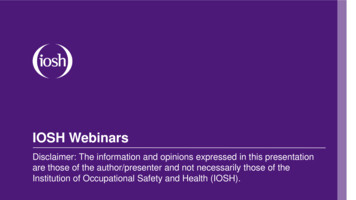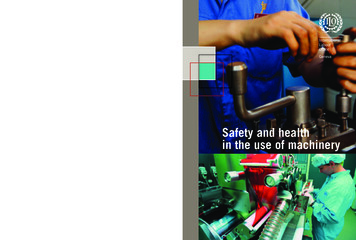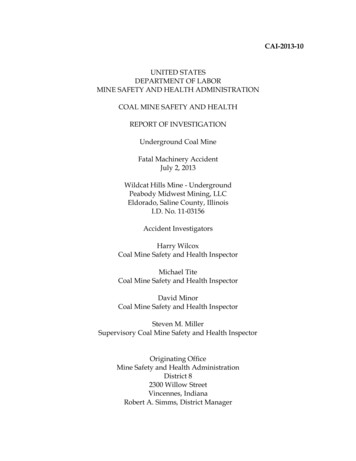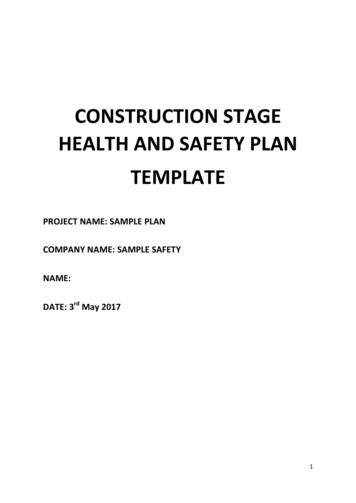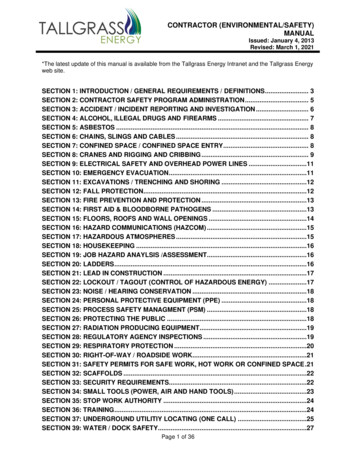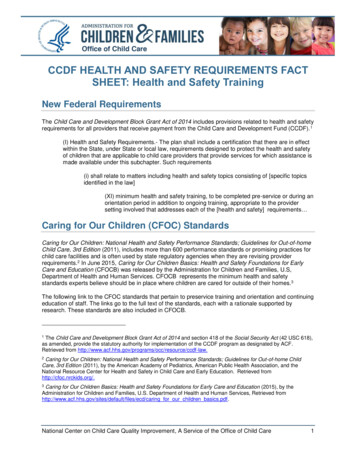
Transcription
CCDF HEALTH AND SAFETY REQUIREMENTS FACTSHEET: Health and Safety TrainingNew Federal RequirementsThe Child Care and Development Block Grant Act of 2014 includes provisions related to health and safetyrequirements for all providers that receive payment from the Child Care and Development Fund (CCDF). 1(I) Health and Safety Requirements.- The plan shall include a certification that there are in effectwithin the State, under State or local law, requirements designed to protect the health and safetyof children that are applicable to child care providers that provide services for which assistance ismade available under this subchapter. Such requirements(i) shall relate to matters including health and safety topics consisting of [specific topicsidentified in the law](XI) minimum health and safety training, to be completed pre-service or during anorientation period in addition to ongoing training, appropriate to the providersetting involved that addresses each of the [health and safety] requirements Caring for Our Children (CFOC) StandardsCaring for Our Children: National Health and Safety Performance Standards; Guidelines for Out-of-homeChild Care, 3rd Edition (2011), includes more than 600 performance standards or promising practices forchild care facilities and is often used by state regulatory agencies when they are revising providerrequirements.2 In June 2015, Caring for Our Children Basics: Health and Safety Foundations for EarlyCare and Education (CFOCB) was released by the Administration for Children and Families, U.S,Department of Health and Human Services. CFOCB represents the minimum health and safetystandards experts believe should be in place where children are cared for outside of their homes.3The following link to the CFOC standards that pertain to preservice training and orientation and continuingeducation of staff. The links go to the full text of the standards, each with a rationale supported byresearch. These standards are also included in CFOCB.1The Child Care and Development Block Grant Act of 2014 and section 418 of the Social Security Act (42 USC 618),as amended, provide the statutory authority for implementation of the CCDF program as designated by ACF.Retrieved from law.2Caring for Our Children: National Health and Safety Performance Standards; Guidelines for Out-of-home ChildCare, 3rd Edition (2011), by the American Academy of Pediatrics, American Public Health Association, and theNational Resource Center for Health and Safety in Child Care and Early Education. Retrieved fromhttp://cfoc.nrckids.org/.3Caring for Our Children Basics: Health and Safety Foundations for Early Care and Education (2015), by theAdministration for Children and Families, U.S. Department of Health and Human Services, Retrieved /caring for our children basics.pdf.National Center on Child Care Quality Improvement, A Service of the Office of Child Care1
Health and Safety Training (No. 286)August 20151.4.1.1: Pre-service .11.4.2.3: Orientation 1.4.4.1: Continuing Education for Directors and Caregivers/Teachers in Centers and Large FamilyChild Care .4.4.2: Continuing Education for Small Family Child Care Home dView/1.4.4.2Trends in Child Care LicensingHealth and Safety Training TopicsTables #1 and #2 provide information about the number of States4 that have requirements for preserviceor orientation training in specific health and safety topics in their licensing regulations for child carecenters, family child care (FCC) homes, and group child care (GCC) homes.5 These data were collectedprior to the implementation of CCDF reauthorization.FIRST AID AND CPRTable #1: Number of States that Include First Aid and CPR Training in Preservice orOrientation Licensing RequirementsFirst Aid and CPR TrainingFirst Aid Training RequiredCentersFCC HomesGCC Homes(N 53)(N 46)(N 41)514140 Required for At Least One Staff35NANA Required for All Staff18NANA514037CPR Training Required Required for At Least One Staff39NANA Required for All Staff14NANAN the number of States that regulate the type of facility.NA Not applicable. Most FCC and GCC homes only have 1 or 2 adults in the home, and States’ requirements forhomes do not make this distinction.4“States” includes the 50 States, the District of Columbia, and two U.S. Territories – Guam and the Virgin Islands.5These data were collected during 2014 from state child care licensing regulations posted on the National ResourceCenter for Health and Safety in Child Care and Early Education Web site ensing-and-regulation-information/.National Center on Child Care Quality Improvement, A Service of the Office of Child Care2
Health and Safety Training (No. 286)August 2015OTHER HEALTH AND SAFETY TOPICSTable #2: Number of States that Include Health and Safety Training Topics in Preserviceor Orientation Licensing RequirementsCentersFCC HomesGCC Homes(N 53)(N 46)(N 41)Administration of Medication16910Care of Sick Children1336Child Abuse and Neglect381522Child Nutrition and Feeding1377Emergency Preparedness and Response301315Fire Safety734Reducing the Risk of SIDS, Safe SleepPractices161719Shaken Baby Syndrome111211Special Health Care Needs1453Spread of Communicable Disease, UniversalPrecautions, Handwashing30714Transportation, Child Safety Restraints757Health and Safety Training TopicsN the number of States that regulate the type of facility.Annual Training HoursTable #3 shows the average number of ongoing training hours required annually for child care centerdirectors, teachers, and assistant teachers; and for family and group child care home providers andassistants. Across these roles, the average is 14 hours of required annual training.About 50 percent of States include at least one of the health and safety topics listed in Table #2 in thesuggested content for annual training hours. Ongoing training requirements in licensing regulationstypically include a list of content areas from which providers choose.National Center on Child Care Quality Improvement, A Service of the Office of Child Care3
Health and Safety Training (No. 286)August 2015Table #3: Average Number of Annual Ongoing Training Hours Required by Facility RoleFacility Type and RoleAverage Number HoursChild Care Center Director18Child Care Center Teacher15Child Care Center Assistant Teacher16Family Child Care Home Provider12Family Child Care Home Assistant Provider13Group Child Care Home Provider14Group Child Care Home Assistant Provider12Requirements for License-Exempt CCDF ProvidersMost States will allow providers that are exempt from licensing requirements to care for children fromfamilies receiving CCDF child care subsidies. These providers are often caring for children in their homes,but have fewer children in their care than the State’s threshold for licensing. When providers are notrequired to be licensed, some States have established health and safety training requirements for thoseproviders to protect children from harm. Under the new CCDF reauthorization law, all States will have toestablish such requirements for license-exempt providers (except for relatives, at State option).National TrendsA review was conducted by the National Center on Child Care Qualify Improvement (NCCCQI) ofrequirements for three types of home-based providers that are exempt from licensing requirements—exempt FCC homes, care by relatives, and in-home care. This information was compiled from States’statutes, regulations, and policy manuals for their child care assistance programs. Prior to implementation of CCDF reauthorization, twenty-six (26) States required license-exempt home-based providers to complete training in topics related to health and safety and/or early childhooddevelopment. Seventeen (17) States required license-exempt home-based providers to complete this trainingprior to caring for children or within a few months of approval. Thirteen (13) States required providers to complete training on an annual basis. Of these States, seven (7) require providers to complete preservice and annual training. Five (5) States called the required training an orientation. Twenty-one (21) States required license-exempt home-based providers to complete training in firstaid and/or cardiopulmonary resuscitation (CPR) to receive payment from the child care assistanceprogram. Fourteen (14) States required providers to have both first aid/CPR training and other training in healthand safety or early childhood development topics.National Center on Child Care Quality Improvement, A Service of the Office of Child Care4
Health and Safety Training (No. 286)August 2015State ExamplesThe following are excerpts from two States that have requirements for license-exempt CCDF providersthat require health and safety training.6 These States were chosen because they have a comprehensiveset of requirements similar to those required for licensed homes.ARKANSASLicense-exempt FCC homes (1 – 5 children), relatives caring for children in their homes, and in-homecare must complete a registration process to receive CCDF payment. The registration process isconducted by the licensing agency. Homes are inspected prior to registration approval.Minimum Licensing Requirements for Registered Child Care Family Homes /licensing docs/2014%20A4%20RCCFH%20Final%20Filing.pdf300 PERSONNEL301 Caregiver Qualifications and Responsibilities6. Newly registered home providers shall attend Family Child Care Provider Training within thefirst six months of being registered.8. The caregiver shall obtain at least 15 hours of training registered with the Division of ChildCare and Early Childhood Education Professional Development Registry, Department ofEducation, or Department of Higher Education approved training each year in continuing earlychildhood education, which is approved by the Division.Topics appropriate for continuing early education shall include, but are not limited to the following:a. Child growth and developmentb. Nutrition and food servicec. Parent communication and involvementd. Curriculum and curriculum developmente. Developmentally appropriate practice and learning environmentsf. Behavior managementg. Emergency care and first aidh. Administration and management of early childhood program[s]9. At least one caregiver who has a current certificate of successful completion of first aid andCPR from an approved organization shall be on site at all times.Excerpts are copied directly from the States’ regulations and include only the text of the requirementsthat are relevant to the topic.6National Center on Child Care Quality Improvement, A Service of the Office of Child Care5
Health and Safety Training (No. 286)August 2015a. The curriculum shall conform to current American Heart Association or American RedCross guidelines.b. The curriculum shall require hands on, skill-based instruction, as well as practicaltesting. Training and certification that is provided solely “on-line” will not be accepted.c. The instructor shall be qualified and authorized to teach the curriculum and shall becertified by a nationally recognized organization. (Including but not limited to: Health andSafety Institute; EMS Safety Services, Inc.)14. Newly registered caregivers shall attend BAS (Business Administration Scale) training withinthe first six month of being registeredNEW MEXICOAll family home child care providers caring for fewer than five children and receiving child careassistance subsidies or Child and Adult Care Food Program funding must be registered. Specialized staffin the Lead Agency conduct annual announced visits and follow ups, as needed, to registered homeproviders (relatives included).“Part 2: Requirements Governing Registration of Non-Licensed Family Child Care Homes,” in “Chapter 17Non-Licensed Child Care,” in Title 8 Social Services 017.0002.pdf8.17.2.9 CAREGIVER REQUIREMENTS:E. Primary and secondary caregivers are required to attend six (6) hours of training annually.Training documentation must be maintained for three (3) years and include the caregiver’s name,the date of training, instructor’s name and signature, topic of training and number of hourscompleted.F. Primary caregivers caring for infants shall receive two hours of infant specific training within sixmonths of registration.G. Primary caregivers are required to attend first aid training during their first year of registration.H. Remaining hours of training shall be within the seven competency areas. The competencyareas are:1) child growth, development and learning;2) health, safety, nutrition and infection control;3) family and community collaboration;4) developmentally appropriate content;5) learning environment and curriculum implementation;6) assessment of children and programs; and7) professionalism.Resources Healthy Child Care America has online courses available on its Web site athttp://www.healthychildcare.org/ProfDev.html. Courses include: Influenza Prevention & Control: Strategies for Early Education and Child Care Providers; Reducing the Risk of SIDS in Early Education and Child Care Online Module;National Center on Child Care Quality Improvement, A Service of the Office of Child Care6
Health and Safety Training (No. 286)August 2015 Medication Administration in Early Education and Child Care Online Module; and Preventing and Managing Infectious Diseases in Early Education and Child Care Online Module. Early Educator Central: Pathways to Credentials and Degrees for Infant-Toddler Educators is aWeb portal sponsored by the Office of Child Care and Office of Head Start that pulls together, in onelocation, existing coursework that is specific to infant-toddler teachers and providers. It also includescourses for early childhood program administrators, trainers, coaches, and consultants who supportdirect service staff. Early Educator Central is available at https://earlyeducatorcentral.acf.hhs.gov/. Child Care Aware of America has information and resources related to health and safety training onits Web site at /training/health-and-safety-training. State-by-state data about licensing requirements for preservice qualifications and ongoing traininghours are available in the Data Explorer tool on the Child Care Technical Assistance Network Web siteat https://childcareta.acf.hhs.gov/data. COMING NEXT YEAR!Healthy Child Care America and the American Academy of Pediatrics are working on additional onlinetraining modules. Topics include: Prevention and response to food allergies; Safety and injury prevention; Shaken baby syndrome; Emergency preparedness and response planning; Transportation and passenger safety; Age-appropriate nutrition, feeding, support for breastfeeding, and physical activity; Recognition and reporting of suspected child abuse and neglect; Caring for children with special health care needs; and Child development.National Center on Child Care Quality Improvement, A Service of the Office of Child Care9300 Lee Highway, Fairfax VA, 22031 Phone: 877-296-2250 Email: OCCQualityCenter@icfi.comNational Center on Child Care Quality Improvement, A Service of the Office of Child Care7
FIRST AID AND CPR . Table #1: Number of States that Include First Aid and CPR Training in Preservice or Orientation Licensing Requirements . First Aid and CPR Training Centers (N 53) FCC Homes (N 46) GCC Homes (N 41) First Aid Training Required 51 41 40 Required



